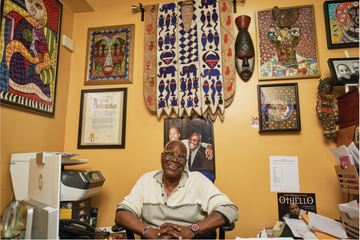Tucked away in the basement of an unassuming brownstone on 130th Street is an exhilarating find for Harlem’s music aficionados. Every Monday, the New Amsterdam Musical Association holds open mic nights, where anyone is welcome to join in and perform. When the Manhattan Sideways team and I visited during the summer of 2017, we witnessed everything from original pieces written by up-and-coming singers to spoken word poetry to jazz played on a hodgepodge of instruments. In short, everyone with a talent or passion is welcome and encouraged to share their art at these jam sessions. The atmosphere is laid back and fun, helped along by the charismatic presenter’s boundless enthusiasm as he announces each act. “This is the way to enjoy a Monday, ” he shouted, to the roaring approval of the assembled audience. We were frequently invited to respond to and interact with the performers, either through singing along to a chorus or participating in a call-and-response chant. It was easy to get caught up in the energy of the performers. As I watched, one of the jazz players asked if there was a singer in the house. Without hesitating, a young man who had just moved to the city from Texas jumped up and improvised some lyrics to a blues song as the makeshift band behind him free-styled along. It was fantastic to witness a group of people of different ages and backgrounds who have never met before come together for the simple pleasure of creating something for everyone to enjoy. As I chatted with some of the people around me, I learned that NAMA provides an ideal platform for aspiring artists to practice in front of a non-threatening public, while more experienced artists still view it as a chance to experiment with their craft, knowing they will never be received with anything less than cheers and approval. We were lucky enough to witness one of these experiments: one performer tried out ways to “mix art forms” by reciting a poem that transitioned into snippets of songs, all with the accompaniment of the jazz band. The presenter’s response to her performance summed it up perfectly for me: “Every time you come to NAMA, you’re making history, because this place itself is history. ” A banner draped above the stage declares that NAMA was established in 1904, making it the oldest African American musical organization in the US. Pieces of its distinguished history are proudly displayed on the walls, including framed newspaper articles that feature NAMA and pictures of past performers, which include the likes of John Coltrane and Max Roach. The Association was created to fill a gap during a time when black musicians were denied performance opportunities or entry into American musical institutions, and it has since upheld the tradition of promoting African American artistry. Open mic nights are only one aspect of what the New Amsterdam Musical Association does. It also has an affiliated music school, where anyone can take vocal or instrumental lessons free of charge, regardless of age or skill level. Through this and their ongoing events, the organization hopes to foster an appreciation for music and its importance in creating and uniting a community.

